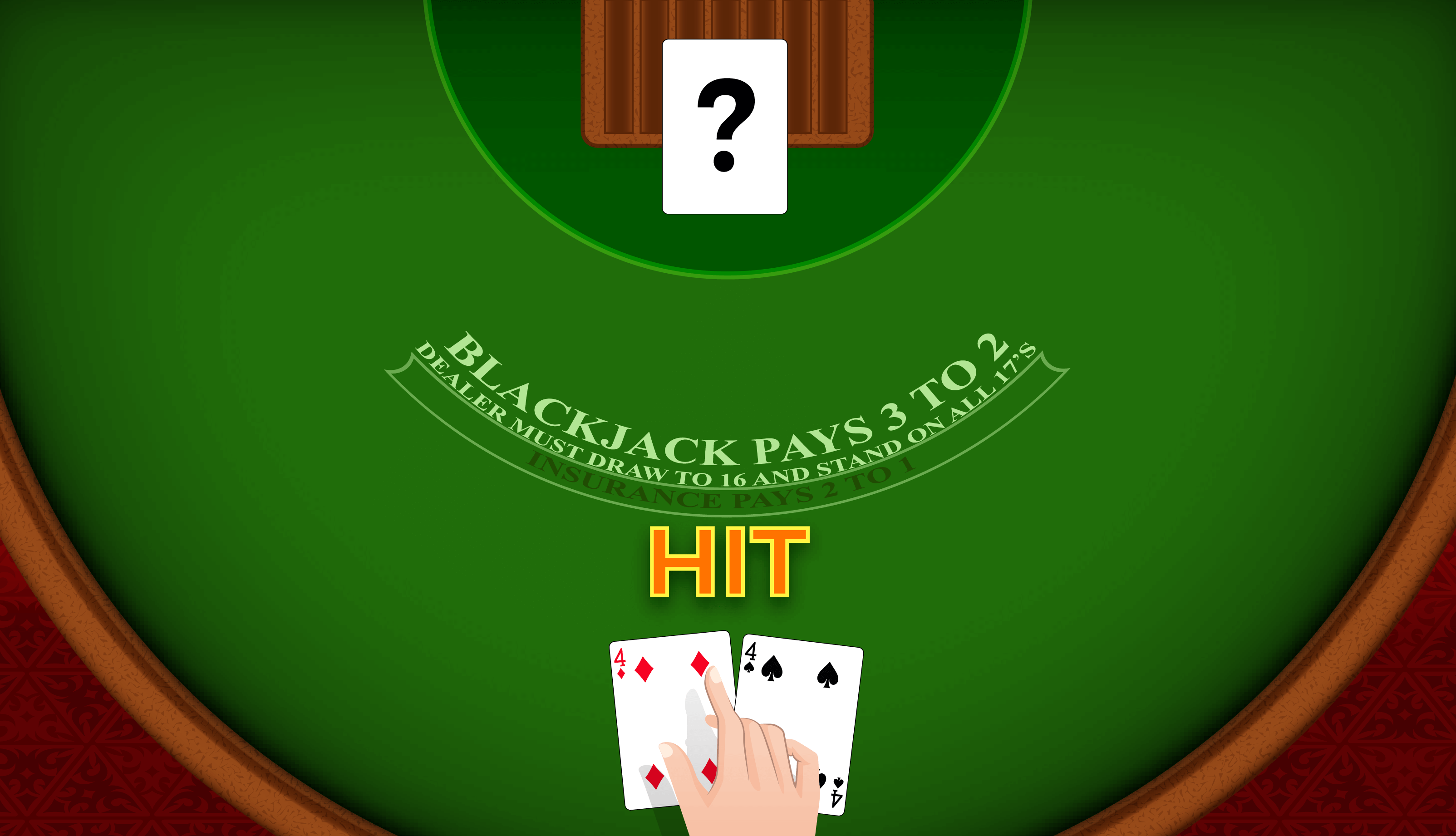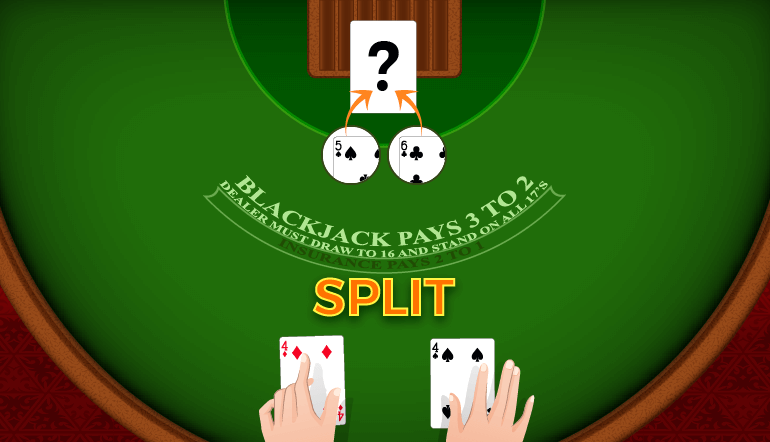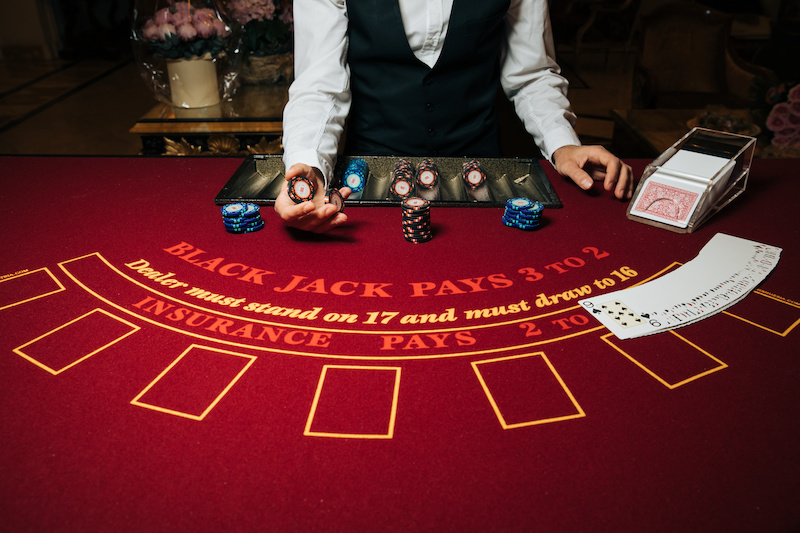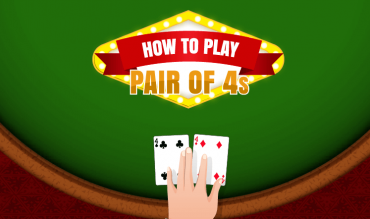This expert strategy guide explains how to play blackjack when you’ve been dealt a pair of 4s. If you want to activate a lower house edge in blackjack games—you need to make the right decisions by using basic blackjack strategy.
BLACKJACK STRATEGY GAMEPLAY WHEN DEALT A PAIR OF 4S
Knowing how to play a pair of 4s can be tricky especially when the stakes are real and the value of the dealer’s upcard is placing you under pressure. This, how to play a pair of 4s blackjack guide is written by blackjack expert Henry Tamburin who’s figured it all out for you, so you’ll know what the best decisions are.
POSSIBLE ACTIONS WHEN DEALT WITH A PAIR OF 4S IN BLACKJACK
When you are dealt a pair of 4s in blackjack you have three viable playing options:
-
to hit on a pair of 4s
-
to split a pair of 4s
-
to double down a pair of 4s
FACTORS TO CONSIDER WHEN FACED WITH A PAIR OF 4S IN BLACKJACK
Which blackjack strategy you should invoke depends upon:
- what the dealer’s upcard is
- the number of decks of cards being used
- whether double down after pair splitting is allowed
BLACKJACK RULES AND THE USE OF BASIC STRATEGY ON PAIRS OF 4S
When it comes to a pair of 4s (total hand value = 8), if you want to increase your chances of winning, this blackjack tips strategy guide explains in what situations you should hit, split or double down. Because it contains expert, blackjack game odds analysis, it will help you navigate blackjack rules for pairs of 4s and the use of basic strategy.
Pair of 4s blackjack playing strategy #1
The basic strategy for a double- or multi-deck game where doubling down after pair splitting is not allowed (NDAS) is to
- Always hit regardless of the dealer’s upcard

Pair of 4s blackjack playing strategy #2
If the blackjack rules allow doubling down after pair splitting (DAS)
- You should split against a dealer’s upcard of 5 and 6

Pair of 4s blackjack playing strategy #3
In a single-deck game, the basic playing strategy is
- If NDAS, double down your total of 8 against a dealer’s upcard of 5 and 6; otherwise hit
- If DAS, split against dealer’s upcard of 4, 5, or 6; otherwise hit
The following color-coded blackjack charts summarize the basic strategy for a pair of 4s.
(Note: P = Split; H = Hit; Dh = Double Down if allowed otherwise hit.)
DOUBLE- AND MULTI-DECK WITH NDAS
| 2 | 3 | 4 | 5 | 6 | 7 | 8 | 9 | 10 | A |
| H | H | H | H | H | H | H | H | H | H |
DOUBLE- AND MULTI-DECK WITH DAS
| 2 | 3 | 4 | 5 | 6 | 7 | 8 | 9 | 10 | A |
| H | H | H | P | P | H | H | H | H | H |
SINGLE-DECK WITH NDAS
| 2 | 3 | 4 | 5 | 6 | 7 | 8 | 9 | 10 | A |
| H | H | H | Dh | Dh | H | H | H | H | H |
SINGLE-DECK WITH DAS
| 2 | 3 | 4 | 5 | 6 | 7 | 8 | 9 | 10 | A |
| H | H | P | P | P | H | H | H | H | H |
REASON FOR USING BLACKJACK STRATEGIES WHEN DEALT PAIRS OF 4S
Whether you should hit, split, or double down is based on one of these three criteria:
- You will win more money on average
- You will lose less money on average
- You will turn a losing hand into a winning hand on average
EXAMPLES FOR WHEN TO SPLIT PAIRS OF 4S IN BLACKJACK
For example, suppose you are dealt a pair of 4s in a six-deck game with DAS and the dealer’s upcard is a 6, the basic playing strategy (shown in the above chart) states to split. The reason is because using a blackjack splitting strategy has a greater positive expectation of winning than either hitting or doubling down.
In other words, you will win more money in the long run by playing two hands, each starting with a 4, than by either hitting or doubling an 8 (i.e, a pair of 4s).
Here’s another example: suppose you are dealt a pair of 4s in a six-deck game with NDAS and the dealer’s upcard is a 3. Doubling and splitting have negative expectations whereas hitting has a positive expectation, making it the best play.
RESPLITTING A PAIR OF 4S WITH EXAMPLES
Understanding the strategy of blackjack pair splitting and knowing exactly when to resplit those 4s can significantly impact your long-term success at blackjack tables.
A final example is being dealt a pair of 4s in a single-deck game against a dealer’s 6 upcard. If the rules specify NDAS, all three viable playing options (hitting, splitting, and doubling) have positive expectations but doubling is more positive making it the better play.
If the playing rules allow you to resplit a pair of 4s, then it is advantageous for you to use a blackjack resplitting strategy. For example:
- If you were dealt a pair of 4s against a dealer’s 5 upcard with DAS, you should split.
- Suppose on the first 4, you are dealt another 4 on the draw. You should resplit to form a third hand.
- If the casino allows resplits up to a total of four hands, then you should resplit again if you are dealt another 4. Resplitting pairs is a player-favorable option that you should always take advantage of.
IF THE BLACKJACK RULES DON’T ALLOW DOUBLING DOWN ON 8
If the blackjack playing rules don’t allow you to double down on an 8, then you should hit (see single-deck chart above with NDAS).
*** For even more blackjack strategies, check out our article on blackjack side bets. ***
IMPACT OF BLACKJACK RULES AND USE OF BASIC STRATEGY ON PAIRS OF 4S
When facing a pair of 4s in blackjack, mastering basic blackjack strategy is crucial for any player aiming to improve their odds of winning. By integrating this knowledge into your overall approach to learning how to play a pair of 4s in blackjack, you can gain a long-term edge of increasing your chances of winning.
You will always win more or lose less if you follow the above basic playing strategy for splitting, hitting, or doubling down on a pair of 4s.
[For a complete basic playing strategy for any set of playing rules, consult Chapter 3 in the Ultimate Blackjack Strategy Guide.]

QUESTIONS AND ANSWERS RELATED TO PAIRS OF 4S IN BLACKJACK
Is basic strategy used to decide how to play a pair of 4s?
Yes, because basic strategy is a rule-based structure players can use for playing blackjack when faced with pairs of 4s, basic strategy suggests the mathematically advantageous play in the long run.
Does card counting give you an advantage when playing pairs of 4s?
Using basic strategy, the recommendation is you to split against a dealer's 5 or 6, but some players deviate from this and double their blackjack hand if the card count is 2 or higher.
Card counting is a higher-level blackjack strategy that deviates from basic strategy rules. With a pair of 4s, card counters could work out that certain value cards are due which could lead them to go against basic strategy and try to gain a stronger advantage over the house.
What is the best way to play a pair of 4s in blackjack?
If a player has a pair of 4s, it’s best to split if the dealer's upcard is 5 or 6. Also, it’s a strong play to double after splitting (if blackjack rules allow) if the dealer's upcard is 5 or 6. When the dealer’s upcard value isn’t 5 or 6, the best thing to do is to hit to try and improve your hand.
Should pairs of 4s be resplit in blackjack games?
The best way to play a pair of 4s from a single blackjack hand is to resplit if dealt another 4 and blackjack rules allow resplit. It’s best to continue to resplit multiple pairs of 4s if you can.
When to hit with a pair of 4s in blackjack hands?
Try to improve your pair of 4s hand by hitting if the value of the dealer’s upcard isn’t 5 or 6.
*** For further reading, check out our article on roulette odds and craps strategy. ***
